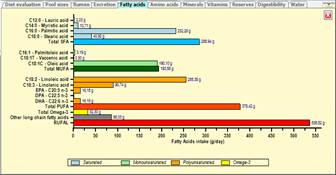
NDS includes the Lipid sub-model developed by Moate et al. (2004) that describes the ruminal digestion and metabolism of long-chain fatty acids (LCFA). The sub-model attempt to estimate three important measures of total and individual fatty acid (FA) flows (g/day) in cows fed a specific TMR:
- flow of FA consumed
- rumen outflow of FA
- flow of absorbed FA in the intestines
It provides valuable assistance into decisions about manipulating lipid intakes by cows to enhance performance. However, some significant improvements were made which are only proposed by the NDS Lipid sub-model.
Omega-3 Polyunsaturated Fatty Acids (Omega-3 PUFA), have become a hot topic in dairy cattle nutrition as new research and on-farm trials provide additional information on how critical they are for the dairy cow and how they can impact each stage of the cow’s lifecycle.
Omega-3 PUFA cannot be produced by the cow using other available nutrients or chemical pathways. The only way Omega-3 PUFA can be supplied to the cow is through the diet and they can generate various positive effects. The beneficial role of Omega-3 PUFA related to inflammatory diseases and health are well documented and feeding Omega-3 PUFA supplements to dairy cows could strengthen the immune systems of cows. Also, the supplementation with Omega-3 PUFA can improve reproductive performance helping some specific reproductive functions like the production of specific hormones, especially progesterone, the production of prostaglandins in order to establish new estrous cycles and they promote integrity of the cow’s cell walls.
These considerations have led us to extend the feed characterization for fatty acids, introducing the very long chain n-3 fatty acids such EPA, DPA and DHA into the feed FA profile.
The proper feeds characterization for the extended FA profile, allows NDS to get an extended Fatty acids diet evaluation, including EPA, DPA and DHA (Omega-3 PUFA).
